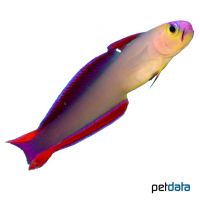Elegant Firefish (Nemateleotris decora)
| Elegant Firefish Nemateleotris decora | |
|---|---|
| Name | Elegant Firefish |
| Name Lat. | Nemateleotris decora |
| Family | Gobies |
| Family lat. | Gobiidae |
| Order | Gobies |
| Order lat. | Gobiiformes |
| Origin | Indo-Pacific |
| Habitat | Rocky reefs |
| Diet | Planktivore |
| pH | 8.1-8.4 |
| Hardness | 8-10 °KH |
| Behavior | Peaceful |
| Keeping | Pair |
| Reef Compatible | Yes |
| Care Level | Difficult |
| Life Span | 3-5 years |
| Protection | No |
| Metric Units | |
| Size | 9 cm |
| Temperature | 23-28 °C |
| Salinity | 33-36 ‰ |
| Aquarium | ~ 200 l |
| US Units | |
| Size | 3" |
| Temperature | 73-82 °F |
| Salinity | 1.020-1.025 sg |
| Aquarium | ~ 50 gal |
Distribution and habitat
Nemateleotris decora are widely distributed in the tropical Indian and Pacific Oceans, from Mauritius to Samoa and from the Ryukyu Islands to New Caledonia. They usually live in pairs in the sandy, boulder-rich zones of heavily circulated reefs at depths of 25-70 m.
Maintenance
They need a well-structured aquarium with a reef structure (caves, crevices), with live rocks that they can graze on and that act like a biological filter, and deep, free sandy areas
Only lime-rich, heavy metal-free sands, gravels, stones or sea sand of various grain sizes may be used as substrate
Filters, skimmers and heaters are necessary to ensure water quality, as well as pumps to simulate tides, swells and bottom currents. Lighting must correspond to the species-appropriate day-night rhythm of the animals
| Salinity: 33-36 ‰ | pH value: 8.1-8.4 |
| Carbonate hardness: 8-10 °KH | Nitrate content: 2-8 mg/l |
| phosphate content: 0.01-0.1 mg/l | nitrite content: 0.0-0.05 mg/l |
For salinity, an average value should be aimed for, which may only vary slightly by +/- 0.5 ‰. Ammonia and ammonium must not be measurable. Special attention must be paid to constantly good water quality.
Diet
In nature they feed mainly on zooplankton. The feed change usually succeeds without problems. The food supply should consist of a commercially available, vitamin-enriched frozen special food mix for plankton eaters or a combination of live and frozen food, such as small mysis, krill, bosmids and artemia, as well as live cyclops, which also serve to keep them occupied. High-quality flake and granulated food is also often accepted after an acclimation period
It is recommended to feed small portions several times a day. Regular and varied feeding promotes health and increases resistance.
Behaviour and compatibility
They are monogamous and should be kept in pairs. Within the species they occasionally behave territorially. Keeping several pairs is only recommended in a larger and richly structured tank. Towards other fish they behave peacefully. They should only be socialized with other calm and peaceful fish, as they are very susceptible to stress.
Sex dimorphism
There are no known external distinguishing characteristics.
Reproduction and breeding
There are no known reports of successful breeding in the aquarium.
Important
At night or in case of danger they retreat into self-dug caves under stones or coral blocks, accordingly the reef construction must be well secured. Suitable caves are e.g. stones lying hollow on the sand. Since they are very skittish and like to jump, the aquarium should be well covered.
If different species are kept together, care should be taken to ensure that the fish match each other in terms of water quality and temperature requirements, as well as their social behavior, and that the setup meets the needs of all species kept together. New fish to be introduced must be acclimated slowly to the water in the aquarium
Further literature can be found in your pet store.
References
Text: Werner Winter; Image: petdata
Source: KUITER, DEBELIUS (2007): Atlas der Meeresfische: Die Fische an den Küsten der Weltmeere, Kosmos Verlag; BAENSCH & DEBELIUS (2006): Meerwasser Atlas Bd. 1, Mergus Verlag; ENGELMANN (2005): Zootierhaltung - Tiere in menschlicher Obhut: Fische, Verlag Harri Deutsch
- Gemäß § 21 Abs. 5 Tierschutzgesetz idgF
